Planting and growing potatoes using the Mittlider method for high yields
If you have a small plot of land, the main purpose of which is to provide the whole family with vegetables all year round, this article is for you. From it you will learn about simple and effective method of growing potatoes Mittlider method.
Who is Mittlider
Jacob Mittlider - international agricultural consultant, who studied the experience of gardening and vegetable gardening in different countries of the world.
Doctor of Agricultural Sciences. The author of a unique method of growing vegetables that guarantees high yields under different agroclimatic conditions.
The general essence of planting and growing potatoes and other vegetables according to Mittlider
Mittlider developed a method of growing vegetable crops, including potatoes, that allows a good harvest from a small area with minimal care. To do this, it is important to follow the methodology to the smallest detail, since a minor violation of the rules negates all efforts.
The general essence of the method consists of the following features:
- lack of soil loosening during the growing season;
- permanent location of beds and row spacing;
- adding minerals fertilizing;
- regular watering;
- ideal lighting of the area;
- mandatory horizontal arrangement of beds.
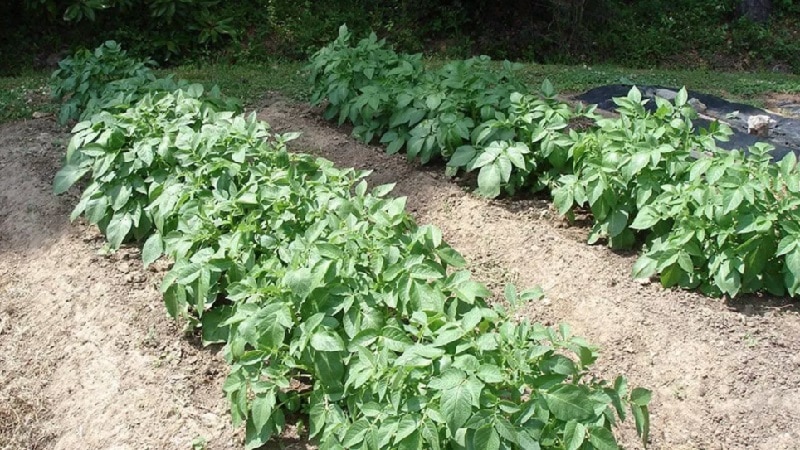
According to the presented theory, the entire area of the land plot is divided into ridges 45 cm wide and 9 m long at a distance of 100 cm from each other.The beds are fertilized, watered and cultivated without worrying about weeds in the rows, which stop growing due to the compaction of the earth.
Advantages and disadvantages of the method
Growing Potatoes according to Mittlider has a number of advantages:
- there is no need to loosen the soil and hilling up beds;
- saving space;
- high performance productivity;
- versatility of technology.
Disadvantages of the technology include:
- restrictions on the relief (slopes, lowlands, lands rich in peat and waterlogged areas are not recommended for use);
- financial costs for the purchase of mineral fertilizers;
- high requirements for lighting levels;
- It is mandatory to have a nearby source of water.
Advantages of narrow beds
The main advantage of Mittlider beds is their width. With small ridge sizes, plants receive more light, oxygen and nutrients, and therefore develop much faster. After harvesting, the free space is sown with fast-growing lettuce, the roots of which, when rotting, replenish the substrate with organic fertilizer.
Other ways to grow potatoes:
Pros and cons of planting potatoes in ridges
Suitable potato varieties
For planting potatoes on narrow beds, it is recommended to use zoned varieties, adapted to local agroclimatic conditions. As for the timing of ripening, there are no restrictions: both early and late varieties are suitable.
How to plant
According to the Mittlider method, potatoes are grown according to certain rules. At the same time, the climatic characteristics of the region are also taken into account.
Reference. Experts advise switching to narrow beds gradually, starting with a small number - 5-6 beds, the length of which does not exceed 8 m.
Preparing Potatoes
The technique involves careful selection of planting material. The author does not recommend using small tubers for planting, so seed material is selected from strong specimens.
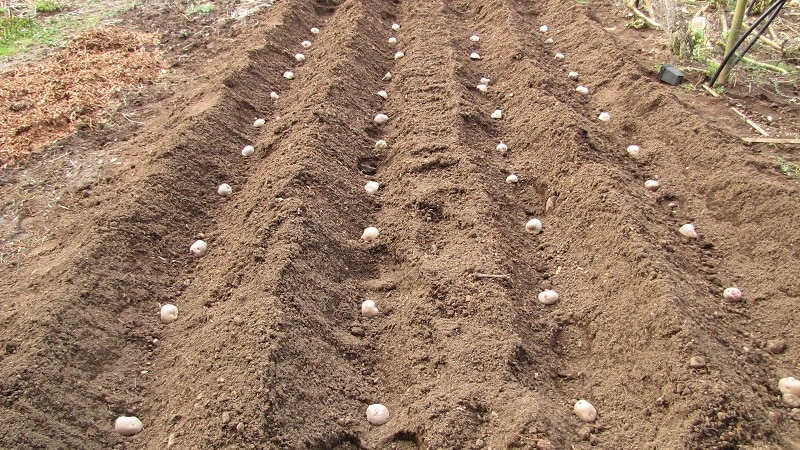
Preparing tubers before planting in beds
Growing potatoes takes place in two stages. First, the potatoes are planted in boxes, after which the young bushes are transferred to the garden bed. This process stimulates plant development, which ensures high harvest indicators.
Selected tubers are first disinfected:
- Soak in hot water (50-60°C) for 15 minutes.
- Soak for 7-10 minutes in a solution of copper sulfate or potassium permanganate.
- Place in boxes with soil for sprouts to appear.
- Exposed to the sun.
- Spray with superphosphate solution once a week.
- As soon as the potatoes sprout, the tubers are cut into several parts so that each has a sprouted eye.
Preparing seedlings
To grow potato seedlings, the tubers are placed in boxes, the bottom of which is filled with a layer of sawdust, previously spilled with a 0.2% solution of copper sulfate. The thickness of such a layer should be approximately 3 cm. The planting material is laid out closely and sprinkled with a second layer of sawdust.
Filled boxes are placed in a cool (+12...+14°C), well-lit place. After short sprouts appear, the tubers are ready for planting. 2 hours before removing them from the boxes, they are spilled with a solution of complex fertilizer, for example, “Zdraven Aqua”.
Landing scheme and rules
Potatoes are planted in flat horizontal beds located in the direction from north to south. Otherwise, moisture and fertilizer accumulate on one side, which leads to uneven development of plants.
Each tuber is transferred to a prepared hole along with sawdust and planted in a checkerboard pattern in two rows with the eyes facing up. The surface of the bed is sprinkled and leveled with a rake.
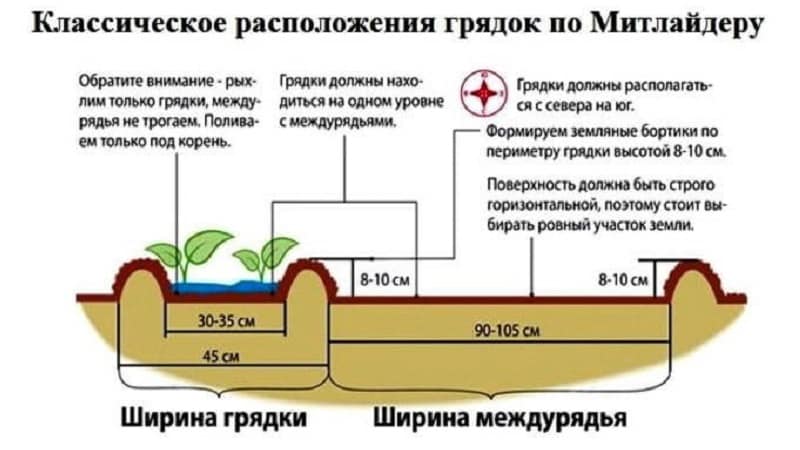
Planting tubers under straw
Some gardeners practice planting potatoes under straw, protecting plantings from bad weather conditions and the germination of weeds.
The protective layer retains heat and moisture, as well as promotes soil saturation useful substances. Its thickness should be 10 cm.
Site breakdown
The marking of the ridges is carried out once a year. To properly divide the area for narrow beds:
- Select a flat place, well lit by the sun.
- They dig up the ground in the fall, removing plant roots and weeds, and apply fertilizer.
- In the spring, using rope and pegs, mark out beds 45 cm wide, positioning them from north to south to achieve maximum light levels throughout the day. The distance between the beds is from 0.7 to 1 m.
- Another rope is pulled in the center of each strip, along which a shallow groove is dug for applying fertilizer.
- After adding the mineral mixture, the bed is dug up to the depth of a spade bayonet. The soil is well loosened.
- The soil surface is leveled with a rake.
- On both sides of the beds, earthen sides (up to 10 cm high) are formed to save moisture and control weeds.
- Prepare the holes by placing them in two rows in a checkerboard pattern at a distance of 30 cm from each other. Wherein hole depth ranges from 7 to 12 cm.
- The row spacing is not dug up.
- During subsequent plantings, nothing is changed in places.
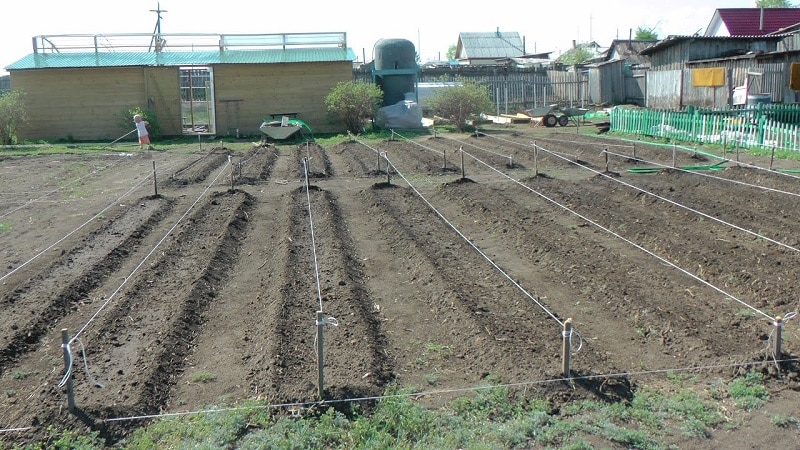
To achieve the desired result compliance with these rules is mandatory.
Mulching
To protect against the proliferation of weeds, drying out and heat loss, the beds are mulched immediately after planting.. Natural materials such as rotted compost, hay, tree bark, humus, and chopped reed are used as mulch.
The listed substances will not only protect young plants, but also have a positive effect on the soil structure. In the cold season, it is not recommended to mulch plantings with polyethylene, and in the summer it is better to avoid organic materials.
Top dressing
Well-chosen feeding – one of the important factors for successful potato growing. To do this, use mixtures of mineral fertilizers compiled by the doctor himself.
You can purchase them in specialty stores or prepare them yourself. The author of the technique advises carrying out three feedings during the growing season, using mixtures No. 1 and No. 2 of our own design: simultaneously with planting, when the plant reaches a height of 15 cm and before the buds open.
Mixture No. 1 consists of 40 g of boric acid and 5 kg of dolomite flour. For 1 sq. m of beds take 100 g.
Mixture No. 2 includes 0.5 kg of magnesium sulfate, 1.4 kg of ammonium nitrate, 0.6 kg of ammophos, 5 g of molybdic acid, 1.1 kg of potassium sulfate, 5 g of boric acid. For 1 sq. m take 50 g.
When feeding, apply first the first mixture, then the second. When digging the soil, scatter 100 g of mixture No. 1 per linear meter, and then 50 g of mixture No. 2.
Important! Fertilizers are applied into a special groove up to 5 cm deep, made in the center of the bed, and sprinkled with earth. During watering, nutrients penetrate the soil and are absorbed by the roots of the plant.
Watering mode
Since potatoes planted in beds are shallow, they need frequent watering. Therefore, it is necessary to monitor the soil moisture level daily. If the soil is dry at a depth of 6-8 cm, it is moistened at the rate of 1-2 buckets of water per linear meter. Watering is carried out both manually and by drip, following the center line of the bed. Soil moistening is stopped at the end of flowering period.
Daily care
Daily potato care consists of watering, which is carried out from the moment of planting until the end of flowering of the bushes, and removing weeds from garden beds. With proper organization of plantings, all other care activities take place according to the technology plan.
Harvesting technology
After flowering, the tops of early varieties begin to ageb. The stems of mid-season varieties turn yellow in August. To speed up this process, the tops are turned to one side and left in this position for 18 days. When the green part of the plant withers, the tubers are dug up. The harvested crop is kept for two weeks in a cool, dry room, after which sent for storage.
Read also:
What difficulties may arise and how to avoid them
When growing potatoes using narrow bed technology some difficulties arise due to violation of the basic rules of the method.
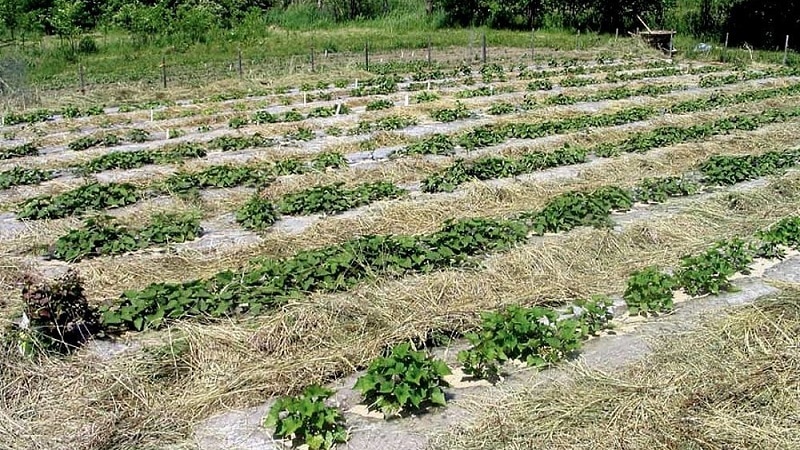
Incorrect watering mode
In the absence of daily watering, the beneficial substances added in fertilizers do not dissolve and do not penetrate deep into the soil. As a result, they accumulate on the surface, having a detrimental effect on plants. In addition, a crust forms on the surface of the earth, preventing the access of air.
Lack or excess of fertilizers
When feeding bushes, you should use mixtures No. 1 and No. 2, developed by Mittlider himself, and strictly follow the recommended dosages of fertilizer application. Otherwise, a good result is not guaranteed.
Poor mixing of fertilizers
When applying fertilizers, it is necessary to carefully dig up the soilso that nutrients are distributed evenly for harmonious growth of bushes along the entire length of the ridge.
Uneven beds
If the bed is located on a slope, water and nutrients will collect on only one side of it, resulting in an uneven growth rate. Therefore, it is necessary to level the surface allocated for the beds as much as possible.
Other
When making nutritional mixtures at home, it is necessary use elements strictly according to a certain composition to prevent their excess. That is why it is not recommended to use complex mineral fertilizers as a component.
Reviews from gardeners about the method
Gardeners speak positively about the Mittlider method.
Vitaly, Perm: “This year I tried out Mitlider’s beds for growing potatoes. The technology is perfect for small plots of land, as it provides a larger harvest than can be obtained in the traditional way.".
Anna, Leningrad region.: “The Mittlider method in the Russian version is quite effective and gives a good potato harvest. The absence of the need for hilling is a big plus in growing this way.".
Svyatoslav, Oryol region.: “The technology makes it possible to save effort and time, because wide paths simplify access to plants”.
Conclusion
Mittlider's non-standard technology significantly reduces labor costs and brings a good potato harvest. It is characterized by accessibility and efficiency, but requires strict compliance with all rules for planting and care.